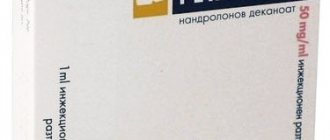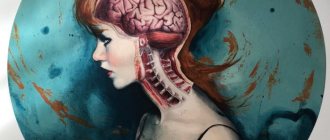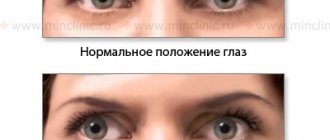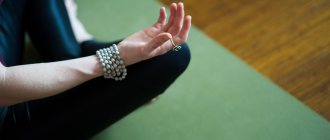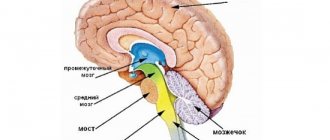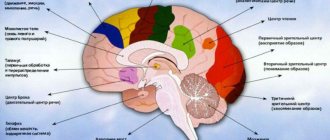The human brain is called the most mysterious and perfect creation of nature. It controls all functions of the body and ensures that a person carries out intelligent activities. Here, all information received from the external environment and internal environment of the body is analyzed and appropriate human behavior is formed. And if animals receive information from specific objects and phenomena, then for humans the word becomes the real signal. Word and speech constitute the second signaling system, unique to humans. The material substrate of the second signaling system and verbal human thinking is the cerebral cortex. Scientists have been trying to unravel the mysteries of the human brain for many centuries, but even now they are still very far from knowing the truth.
Structure and functions of the brain stem
Let us consider the characteristic features of the structure of the brain, starting with its “lowest” section - the trunk, directly bordering the spinal cord.
The brain stem is covered from above and from the sides by the cerebral hemispheres and the cerebellum. Its structure has features similar to the spinal cord; cranial nerves (from III to XII pairs) depart from it, innervating the muscles and scalp, as well as internal organs (respiratory and digestive systems, heart). The brain stem communicates with the spinal cord through special pathways. The brain stem contains centers that are important for the whole organism and are associated with the regulation of breathing, blood circulation, muscle tone, and others. The brainstem combines 3 sections: the medulla oblongata, the pons and the midbrain.
Medulla oblongata The medulla oblongata is a continuation of the spinal cord. Since it is in the medulla oblongata that the vital centers of respiration and blood circulation lie, damage to this section leads to the cessation of respiratory movements, disruption of the heart, a sharp decrease in blood pressure, resulting in rapid death. The centers of vomiting, sneezing and coughing are also located here.
The pons The pons plays an important role in connecting the cerebral cortex with the cerebellum and conducting auditory information.
Midbrain The importance of the midbrain is great for the regulation of skeletal muscle tone, the implementation of protective reflexes in response to strong visual and auditory stimuli, as well as indicative reactions (synchronous rotation of the head and eyes towards the light source).
Brain
Medulla
is a direct continuation of the spinal cord
- responsible for breathing, blood circulation, digestion;
- contains reflexes of coughing, sneezing, swallowing, sucking, vomiting, etc.
Cerebellum
responsible for coordination of movements.
Midbrain
- responsible for indicative reactions to light and sound;
- Provides skeletal muscle tone.
Diencephalon
regulates metabolism in the body, coordinates physiological processes, maintains homeostasis (constancy of the chemical composition and temperature of the internal environment) in two ways:
- through the pituitary gland (with the help of neurohormones) controls all other endocrine glands of the body;
- participates in the formation of feelings of hunger, cold, thirst, etc., thus influencing behavior.
Large hemispheres
the forebrain has sulci and gyri (like the cerebellum)
- in the front part of the frontal lobe there is a zone of logical thinking
(it is better developed in humans than in other animals); - in the back of the frontal lobe there is a motor zone of the body
(responsible for voluntary movements); - in the lower part of the frontal lobe, on the border with the parietal and temporal lobe, there is a speech zone
(it is present only in the human brain, other animals do not have it); - in the anterior part of the parietal lobe there is a sensitive area of the body (zone of musculocutaneous sensitivity)
; - the occipital lobe contains the visual area
; this is the central part of the visual analyzer, here the analysis and recognition of visual images takes place; - in the temporal lobe there is a hearing zone
, this is the central part of the auditory analyzer.
You can also read
DETAILED SUMMARY: Brain
ASSIGNMENTS OF PART 2 OF THE USE ON THIS TOPIC
Part 1 tasks
Choose one, the most correct option. In what lobe of the cerebral cortex are the higher centers of the skin analyzer located?
1) frontal 2) temporal 3) occipital 4) parietal
Answer
4
Choose one, the most correct option. Regulation and coordination of physiological processes occurring in internal organs is ensured by
1) diencephalon 2) midbrain 3) spinal cord 4) cerebellum
Answer
1
Choose one, the most correct option. In humans, compared to mammals, there is a strong development of the next lobe of the cerebral cortex
1) frontal 2) parietal 3) occipital 4) temporal
Answer
1
Choose one, the most correct option. In what lobe of the cerebral cortex is the center of skin-muscular feeling in humans located?
1) occipital 2) temporal 3) frontal 4) parietal
Answer
4
Choose one, the most correct option. Regulation and coordination of physiological processes occurring in internal organs is ensured by
1) diencephalon 2) midbrain 3) spinal cord 4) cerebellum
Answer
1
Choose one, the most correct option. The medulla oblongata of the human brain does not regulate
1) respiratory movements 2) intestinal motility 3) heart contractions 4) body balance
Answer
4
Choose one, the most correct option. When cells in the temporal lobe of the cerebral cortex are destroyed, a person
1) gets a distorted idea of the shape of objects 2) does not distinguish between the strength and pitch of sound 3) loses coordination of movements 4) does not distinguish between visual signals
Answer
2
Choose one, the most correct option. The final analysis of the height, strength and nature of sound in a person occurs in
1) inner ear 2) auditory nerve 3) eardrum 4) auditory cortex
Answer
4
Choose one, the most correct option. Voluntary human movements provide
1) cerebellum and diencephalon 2) midbrain and spinal cord 3) medulla oblongata and pons 4) cerebral hemispheres of the forebrain
Answer
4
BRAIN Determine the sequence of locations of the brain sections, starting with those closest to the spinal cord. Write down the corresponding sequence of numbers.
1) cerebral hemispheres 2) medulla oblongata 3) diencephalon 4) midbrain
Answer
2431
MEDLINE - CEREBELLUM - INTERMEDIUM Establish a correspondence between the characteristics and parts of the brain: 1) diencephalon, 2) medulla oblongata, 3) cerebellum. Write numbers 1-3 in the order corresponding to the letters.
A) is located directly above the spinal cord B) ensures accuracy and coordination of movements C) contains the center of respiration D) has grooves and convolutions E) includes the hypothalamic-pituitary system E) the centers of hunger, thirst, and satiety are located
Answer
232311
OBLEGATE - MIDDLE - INTERMEDIATE Establish a correspondence between the characteristic and the part of the human brain: 1) middle, 2) intermediate, 3) oblong. Write numbers 1-3 in the order corresponding to the letters.
A) contains centers of orientation reflexes B) contains the respiratory center C) is involved in the regulation of body temperature D) is located above the pons E) contains centers of protective reflexes (sneezing, coughing) E) is responsible for the feeling of hunger and satiety
Answer
132132
OBLADUS - INTERMEDIATE Establish a correspondence between the processes and parts of the brain that regulate these processes: 1) intermediate, 2) oblongata. Write numbers 1 and 2 in the order corresponding to the letters.
A) regulation of blood glucose levels B) preservation of smooth muscle tone C) control of body temperature D) humoral regulation E) direct regulation of heart rate E) ensuring intestinal motility
Answer
121122
OBLEGNADE - FOREIGN 1. Establish a correspondence between the structural features and functions of the human brain and the section for which they are characteristic: 1) medulla oblongata, 2) forebrain. Write numbers 1 and 2 in the correct order.
A) contains the respiratory center B) the surface is divided into lobes C) perceives and processes information from the senses D) contains (includes) the vasomotor center E) contains the centers of the body’s defense reactions - coughing and sneezing
Answer
12211
2. Establish a correspondence between the function of a part of the human nervous system and the part that performs this function: 1) medulla oblongata, 2) cerebral cortex. Write numbers 1 and 2 in the correct order.
A) regulates the activity of the cardiovascular system B) is responsible for the development of conditioned reflexes C) contains the respiratory center D) analyzes visual and auditory stimuli E) triggers the cough and sneeze reaction E) controls fine finger movements
Answer
121212
INTERMEDIUM - LARGE HEMISPHERES Establish a correspondence between the function of the human forebrain and the section that performs this function: 1) the intermediate brain, 2) the cerebral hemispheres. Write numbers 1 and 2 in the order corresponding to the letters.
A) control of complex muscle movements B) analysis of all incoming information C) regulation of body temperature D) ensuring the constancy of the internal environment of the body E) control of mental and speech activity E) regulation of feelings of thirst, hunger and satiety
Answer
221121
1. Select three correctly labeled captions for the picture “Divisions of the Brain.” Write down the numbers under which they are indicated.
1) diencephalon 2) medulla oblongata 3) midbrain 4) pons 5) cerebral hemisphere 6) cerebellum
Answer
356
2. Choose three correctly labeled captions for the picture depicting the human brain. Write down the numbers under which they are indicated.
1) cerebral hemisphere 2) pons 3) cerebellum 4) hypothalamus 5) medulla oblongata 6) diencephalon
Answer
136
Establish a correspondence between the characteristics and the parts of the brain indicated in the figure by numbers 1 and 2. Write numbers 1 and 2 in the order corresponding to the letters.
A) controls salivation B) ensures coordination of movement C) gray matter is located outside, white matter is inside D) the breathing center is located E) controls the balance of the body E) the centers of protective reflexes (vomiting) are located
Answer
122121
Establish a correspondence between the functions and parts of the human brain, indicated in the figure by numbers 1, 2. Write numbers 1 and 2 in the order corresponding to the letters.
A) forms neurohormones B) maintains the tone of skeletal muscles C) controls the rotation of the head to a sharp sound D) forms feelings of hunger and satiety E) regulates metabolism
Answer
12211
Establish a correspondence between the characteristics and parts of the human brain, indicated in the figure by numbers 1 and 2. Write numbers 1 and 2 in the order corresponding to the letters.
A) contains inhalation and exhalation centers B) is involved in thermoregulation C) is involved in the formation of the feeling of thirst D) controls cardiac activity E) regulates the feeling of hunger and satiety
Answer
12212
Establish a correspondence between the structural features and functions and lobes of the cerebral cortex, indicated in the figure by numbers 1 and 2. Write numbers 1 and 2 in the order corresponding to the letters.
A) is responsible for the perception of light signals B) the auditory sensitivity zone C) is responsible for the perception of sound signals D) if it is damaged, a person goes blind E) the visual zone
Answer
21122
© D.V. Pozdnyakov, 2009-2020
Structure and functions of the cerebellum
The cerebellum is located above the brain stem and is connected to its parts by 3 pairs of peduncles. The cerebellum has 2 small hemispheres covered by the cerebellar cortex. The main functional significance of the cerebellum is to maintain body balance, regulate and coordinate body movements, giving them smoothness, accuracy and proportionality. The cerebellum programs the automatic execution of movements, which is made possible by its connections with the spinal cord, brainstem and cerebral cortex. For example, when walking and running, the cerebellum controls the position and movement of the torso and arms in accordance with the movements of the legs and the movement of the body's center of gravity. When writing, it is responsible for maintaining optimal posture and coordinating the movements of the head, eyes and hands. The cerebellum plays an important role in performing rapid sequential and simultaneous movements, such as the movements of the hands of a pianist or typist.
Structure and functions of the diencephalon
Anterior to the brain stem, between the midbrain and the cerebral hemispheres, is the diencephalon. The upper part of the diencephalon is called the thalamus or thalamus optic, the lower part is the hypothalamus.
The meaning of the thalamus The thalamus, a paired ovoid-shaped formation, is a collector of all types of sensitivity from all parts of the body and sensory organs. From here this information is transmitted to the cerebral cortex. Certain areas of the thalamus are important components of the limbic system of the brain, which controls the psycho-emotional behavior of a person, while others are involved in ensuring memory processes. There is evidence that the thalamus is involved in the perception of pain. Destruction of certain areas of the thalamus can lead to a decrease in anxiety, tension, aggressiveness, elimination of obsessive thoughts, as well as a sharp decrease in motor activity.
The significance of the hypothalamus The significance of the hypothalamus is associated primarily with the regulation of the activity of internal organs. The nuclei of the hypothalamus produce special substances - neurohormones, which enter the pituitary gland, and from it into the blood.
The pituitary gland is an endocrine gland, closely related in structure and location to the hypothalamus. The single hypothalamic-pituitary system of the diencephalon controls the work of other endocrine glands and, with their help, regulates the functions of the body. This system controls the state of water-salt balance, metabolism and energy, the functioning of the immune system, thermoregulation, reproductive function of the body, etc. There is evidence that the hypothalamus contains specific pleasure centers that play an important role in the formation of motivations and emotional forms of behavior . In the area of the hypothalamus there are areas of the optic nerves through which information is transmitted from the retina of the eye.
The significance of the pineal gland The diencephalon also includes the pineal gland, or pineal gland, an endocrine gland that influences the work of other endocrine glands and is involved in the regulation of the seasonal rhythms of the body.
Functions and tasks
Quite a difficult topic to discuss, since the brain does almost everything that you do (or controls these processes).
We need to start with the fact that it is the brain that performs the highest function that determines the intelligence of a person as a species - thinking. It also processes signals received from all receptors - vision, hearing, smell, touch and taste. In addition, the brain controls sensations in the form of emotions, feelings, etc.
It is impossible not to mention that all movements of the human body are also controlled by the brain - even if these are reflex reactions that we are not always aware of.
Structure and functions of the cerebrum
The right and left hemispheres form the so-called telencephalon, or cerebrum, which is the most developed and, in evolutionary terms, a new part of the brain. The work of the cerebral hemispheres is associated with the most complex manifestations of human mental and intellectual activity.
Gray and white matter of the brain The surface of the hemispheres is covered with the cerebral cortex - a layer of gray matter consisting of nerve cells (neurons). It is here that the highest analysis of all received information occurs and human behavior is formed. Under the cerebral cortex in the hemispheres there is white matter formed by the processes of neurons (nerve fibers). Bundles of nerve fibers form pathways that connect the cerebral cortex with other parts of the brain and with the spinal cord. The right and left hemispheres of the cerebrum are connected to each other by a huge number of nerve fibers, the totality of which is called the corpus callosum.
The significance of the basal ganglia In the depths of the white matter of the hemispheres there are accumulations of gray matter - the basal ganglia, which control the automated movements of the body, control and maintain the tone of skeletal muscles, and regulate their heat production. When connections between the basal ganglia and the motor centers of the midbrain are disrupted, parkinsonism develops, which is characterized by severe trembling of the limbs and head. One of the basal ganglia, the amygdala, is an important part of the limbic system of the brain. Its destruction leads to aggressive behavior or, conversely, a sluggish, apathetic state.
Convolutions and grooves of the brain The cerebral cortex forms folds - convolutions, which are separated by grooves. Due to this relief, the surface of the cerebral cortex increases. Deep grooves divide each hemisphere into lobes: frontal, parietal, occipital, temporal, limbic and insular. Smaller grooves within each lobe have an individual pattern and are formed in a person from birth to 7–8 years.
Motor Center Thanks to numerous clinical observations and scientific studies, it has been established that specific brain functions are associated with certain areas of the cortex. Based on the available data, at the beginning of the twentieth century, K. Brodman identified 52 fields of the cerebral cortex, and currently there are more than 200 of them.
According to modern concepts, the motor center is located in the frontal lobe, in the area of the precentral gyrus (on the border with the parietal lobe). Information from the muscles and joints of the body comes here, based on the analysis of which conscious regulation of movements is carried out. When this area of the cortex is damaged (for example, due to a stroke), paralysis of the muscles of the opposite half of the body occurs.
Writing Center and Speech Motor Center The frontal lobe contains the writing center and speech motor center. Defeat of the first leads to disorders of writing skills under visual control (agraphia). The speech motor center has a pronounced functional asymmetry: if it is disrupted in the right hemisphere, the ability to regulate timbre and intonation is lost (speech becomes monotonous); if it is destroyed on the left, the ability for articulate speech (aphasia) and singing (amusia) is lost. With partial disorders, agrammatism is possible - the inability to form phrases correctly. The location of other speech centers in the cortex is also asymmetrical: in right-handed people they develop in the left, in left-handed people - in the right hemisphere of the cerebrum.
Area of the frontal pole A large area of the cortex in the anterior part of the frontal lobe carries out programming of complex forms of behavior: planning actions, making decisions, analyzing the results obtained, volitional reinforcement. The area of the frontal pole is related to the control of a person’s psycho-emotional state. Damage to this area can affect a person’s character, his intellectual activity, value orientations and result in changes in personality structure.
Center of general sensitivity In the parietal lobe, in the postcentral gyrus, there is a center of general sensitivity (pain, temperature, tactile). Violations of the cortex in this area lead to partial or complete loss of sensitivity. Lesions of the cortex in other parts of the parietal lobe contribute to a disorder in the function of recognizing objects by touch, without the help of vision, as well as the ability to perform complex professional movements that require special training. In the area of the cortex of the parietal lobe, on the border with the temporal and occipital lobes, there is a visual (optical) speech center. When it is damaged, the ability to understand readable text is lost (Alexia).
Visual center In the occipital lobe, along the edges of the calcarine groove, the visual center is located. Its damage leads to blindness. If there are disturbances in the areas of the occipital lobe cortex adjacent to the calcarine sulcus, there may be a loss of visual memory, the ability to navigate in an unfamiliar environment, the ability to use vision to evaluate the shape of objects, the distance to them, and correctly measure movements in space.
Auditory center The auditory center is located in the middle part of the superior temporal gyrus. The consequence of its damage is deafness. Near it is the auditory speech center. Injuries in this area result in an inability to understand spoken language, which is perceived as noise. Other areas of the temporal lobe cortex are associated with the activity of the vestibular apparatus. If they are damaged, balance when standing is disrupted.
Limbic lobe The limbic lobe is located on the inner surface of the cerebral hemispheres facing each other. Its cortex controls a complex of functional and behavioral psycho-emotional reactions to environmental influences. The gustatory and olfactory centers are also located here. Associated with the limbic lobe, an area of the evolutionarily old cortex called the hippocampus plays an important role in human learning, as it influences memory mechanisms. The significance of the insular cortex is currently not well understood.
How to improve coordination of movements?
4 minutes
Published:March 30, 2018
| (0) |
Elena Pozhidaeva, coach of the European Gymnastics Center Kievskoye Shosse, spoke about effective ways to train movement coordination in children and adults:
“In humans, the vestibular apparatus is responsible for coordination of movements and balance. Thanks to it, a person can easily navigate in space and can maintain balance even with his eyes closed. Gymnasts have a particularly well-developed vestibular system, since they constantly rotate in the air, perform complex coordination exercises, and practice on equipment that requires balance.
But good functioning of the vestibular apparatus is also necessary in everyday life, including to prevent household injuries.
The vestibular apparatus is located in the inner ear in the temporal region of the head. It receives information about human movements from receptors located on the skin, in muscles, and through the organs of vision. Then, with the help of the nervous system, it transmits it to the brain, from where signals are then sent to the muscular-articular system. This is how muscles contract, change movements, maintain balance, perceive the direction of movement, and the position of the head and body in space unconsciously.
Symptoms of dysfunction of the vestibular apparatus include: motion sickness in transport, dizziness, nausea with various head tilts, while performing somersaults, fear of heights, as well as loss of balance during normal movements and orientation in space. These deviations can manifest themselves in both children and adults, both weak and strong.
But the vestibular apparatus can be trained! First of all, this is necessary for good health and self-confidence. The formation of the vestibular apparatus is completed by the age of 12–15 years, but its development can be carried out throughout life. However, it is important to start from early childhood!
If a person has any of the above complaints that manifest themselves to a strong degree, then classes should begin with light general developmental exercises that can be performed even at home. To achieve results, it is important to maintain regular training – 10-15 minutes every day.
Set of exercises:
1) Tilt your head left and right, back and forth - starting position: standing, feet shoulder-width apart, hands on your belt - 3 times.
2) Turn the head left and right - starting position: standing, feet shoulder-width apart, hands on the belt - 3 times.
3) Turn the body to the right and left - starting position: standing, feet shoulder-width apart, hands on the belt - 5 times.
4) Circular rotations of the head to the right - starting position: standing, feet shoulder-width apart, hands on the belt - 2 times in each direction.
5) Balance on one leg - starting position: standing on one leg, the other bent at the knee and the toe pressed to the opposite knee, hands on the belt. Perform 10 seconds on the right leg, then on the left leg. At first, you can hold on to the support with one hand.
6) Turn around yourself - starting position: standing, feet shoulder-width apart, hands on your belt. Stepping with our feet, we perform a whole turn around ourselves, first to the right, then to the left - 2 times in each direction.
7) Tilt the body to the right/left - starting position: standing, feet shoulder-width apart, hands on the belt. We bend in each direction 3 times. Then we bend to the right/left with one arm raised up.
 Fold, standing feet together - starting position: standing feet together, bend forward, trying to reach your palms to the floor, while keeping your knees straight - hold this position for 5 seconds.
Fold, standing feet together - starting position: standing feet together, bend forward, trying to reach your palms to the floor, while keeping your knees straight - hold this position for 5 seconds.
Then, without lifting your hands from the floor, squat down and return to the starting position again - 5 times.
9) Exercise for the press - raising the body - starting position: sitting on the floor, fix your legs under a support, cross your palms at the back of your head. Slowly lower yourself onto your back, keeping your head on your chest the whole time, and then rise to the starting position without using your hands - 10-15 times.
10) Raising legs on your back - starting position: lying on your back, raise your arms up and hold on to the support. Raise your straight legs above your head, then lower them down – 10 times.
11) Walking on toes - starting position: stand on your toes, stretch upward with both hands, back straight. In this position, take 20 steps forward without bending your knees.
As soon as these exercises no longer cause discomfort, it is important to continue training, but in the gym. The vestibular apparatus can be trained throughout life; gymnastics will be the most suitable sport for this. It allows you to choose different variations of exercises and constantly complicate them, so a person quickly makes progress in developing coordination.
In fact, the entire gymnastics training consists of coordination exercises, which are also aimed at strength, endurance, and flexibility. For example, various general developmental exercises on the floor, walking on a beam, acrobatic elements: somersaults forward and backward, handstands, cartwheels, somersaults, etc., trampoline jumping, overcoming an obstacle course, exercises on parallel bars, rings, wall bars.
The trainer selects the load based on the person’s capabilities, so you can come with absolutely no preparation. The result will be noticeable after 1-2 months of regular training. It will also be useful to supplement gymnastics classes with roller skating, scootering, cycling, figure skating, skiing, and also on a swing.”
If you have any questions, you can consult with our specialists by calling +7 (495) 477 32 69 or leaving a request for a free trial lesson.
Sign up for a free lesson
All articles
Structure of the cerebral cortex
The cerebral cortex is a huge accumulation of nerve cells: according to various sources, from 10 to 14 billion. The thickness of the cortex ranges from 1.2 to 4.5 mm, and the surface area of an adult is from 1700 to 2200 cm2, and compared with the period in newborns it increases approximately 30 times. Nerve cells are located in the cortex in layers and have a certain order. In the evolutionary neocortex, 6–7 layers of neurons are distinguished. Neurons are connected to each other by numerous processes both within each layer and between layers. Long processes of large (so-called pyramidal) neurons of layers III and V extend beyond the cortex and ensure the transmission of information to various parts of the brain and spinal cord. Interneurons (interneurons) carry out intracortical interactions, which is necessary for the exchange of information between neurons located in different convolutions, lobes and hemispheres, as well as for storing and reproducing information (memory).
Groups of interneurons form closed chains, long-term circulation of impulses along which determines memory processes. It is believed that the most superficial layers of the cortex are related to the second signaling system, in which neurons have the ability to create an unlimited number of associations. The hidden activity of many neurons, leading to long-term circulation of excitation in the cortex and related parts of the brain, accompanies cognitive and other higher forms of human mental activity. Research on the microscopic structure of the cerebral cortex as a material substrate of higher nervous activity in humans has enormous potential and largely depends on improving research methods.

